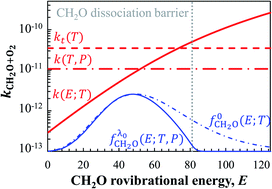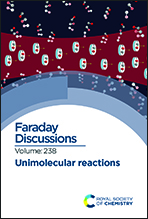Dissociation-induced depletion of high-energy reactant molecules as a mechanism for pressure-dependent rate constants for bimolecular reactions†
Abstract
In 1922, Lindemann proposed the now-well-known mechanism for pressure-dependent rate constants for unimolecular reactions: reactant molecules with sufficiently high energies dissociate more quickly than collisions can reestablish the Boltzmann distribution of the internal energies of the molecule during its dissociation at low pressures – yielding pressure-dependent rate constants for unimolecular reactions due to the preferential depletion of the high energy states capable of dissociation. In the last century, incredible progress has been made in achieving a far greater understanding of and quantitative predictions for unimolecular and association reactions. In the modern era, pressure-dependent phenomenological rate constants are now nearly universally used to describe the rates of unimolecular and associative reactions in phenomenological kinetic modeling. However, there is a second, more indirect, implication of Lindemann’s mechanism that relates to how these dissociation-induced non-equilibrium distributions impact bimolecular reactions, including non-associative bimolecular reactions – which are generally not considered to have pressure-dependent rate constants. Yet, as we show herein, the same high energy states depleted due to dissociation would otherwise react most rapidly in high-activation-energy bimolecular reactions – yielding a mechanism for pressure-dependent rate constants for bimolecular reactions (including non-associative reactions). Here, we present results from a case study for CH2O dissociation, isomerization, and bimolecular reaction with O2 to explore this question. Results from our master equation calculations indicate that the effect of dissociation-induced non-equilibrium distributions on bimolecular reactions can be substantial – even when chemical timescales are well separated from internal energy relaxational timescales (i.e. when the traditional rate constant description would be thought to apply). This effect is found to be more pronounced – and more complex – for bimolecular reactions involving molecular entities whose chemical timescales are merged with the internal energy relaxational timescales. Finally, we present some ideas for discussion regarding what should be considered as “chemical species” in phenomenological kinetic models.

- This article is part of the themed collection: Unimolecular reactions


 Please wait while we load your content...
Please wait while we load your content...